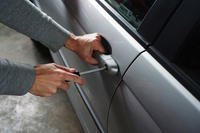After you start your engine, it (usually) runs at a nice steady rumble unless you have a hybrid or electric vehicle (EV). EVs run silently, and hybrids are silent when operating on the electric motor only. The rumble in a conventional vehicle is possible because as soon as the pistons in the cylinders start to go up and down, your engine begins to run on its usual diet of fuel and air. When you let go of the key and your ignition switch moves from "Start" to "On," the electric current stops flowing to the starter but continues to flow through thecharging system (see Figure 5-6) and the rest of the electrical system.
The Alternator
The running engine drives a belt that enables your alternator to produce electriccurrent for the rest of the trip. Here's how it does this: Your alternator (see Figures 5-6 and 5-7) replaces the electricity that was taken from the batterywhen you started the car. Then, every time your battery sends out some of its"juice," the alternator replaces it.
An alternator produces alternating current (AC), which is internally converted to the direct current (DC) needed to drive various gadgets. You occasionally hear the alternator referred to as a generator. Generators are usually found on pre-1964 vehicles. They generate direct current (DC) and pass it on. Today's generators still generate electric current for other uses, but theirautomotive days are over.
When the alternator is generating electric current, it's said to be charging. Although most cars just have dashboard "idiot lights" that go on if the alternator isn't functioning properly, some vehicles have gauges called voltmeters that show whether the system is charging or discharging. They either have a "C" at one end and a "D" at the other end of the scale or a range of voltage levels (usually from 8 to 18).
Tip: With the engine running and all accessories off, the system voltage should be 13.5 to 14.5 volts. If not, something may be wrong with the charging system. The alternator also supplies your electrical system with current to run the radio, headlights, and so on.
The Voltage Regulator
The voltage regulator (see Figures 5-6 and 5-8) is a device that controls the alternator. On older cars, it's a little box mounted somewhere under the hood. On newer cars, it may be mounted inside the alternator or inside the ECU. If the voltage regulator fails, the alternator isliterally "powerless."
From Auto Repair for Dummies, copyright © 2009 by Wiley Publishing, Inc., Indianapolis, Indiana. Used by arrangement with John Wiley & Sons, Inc.










